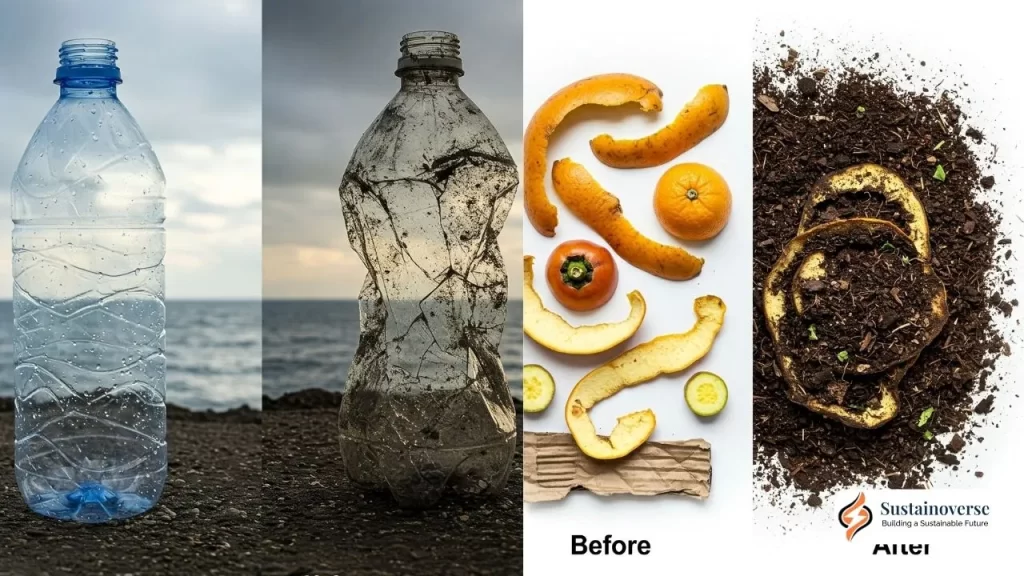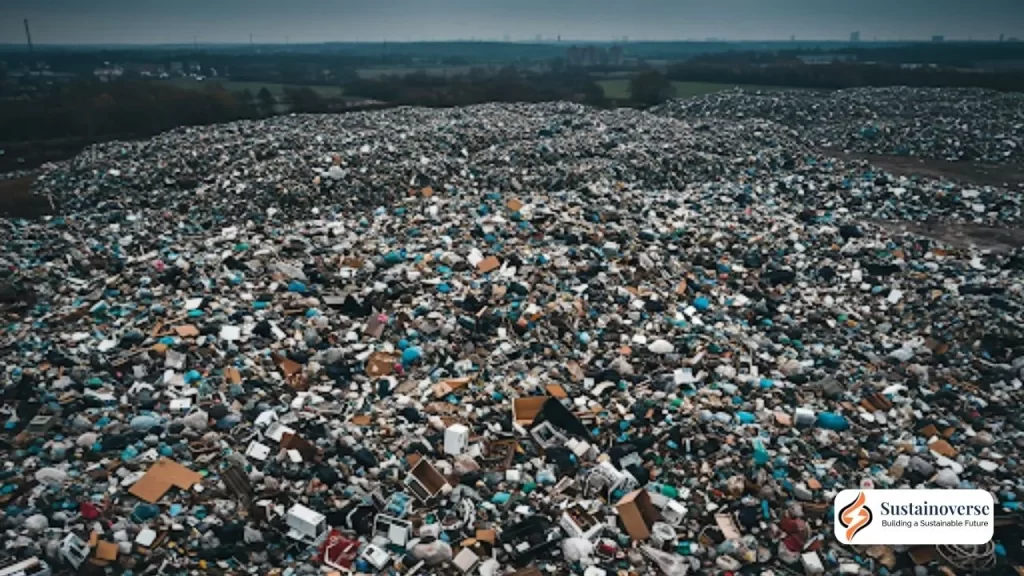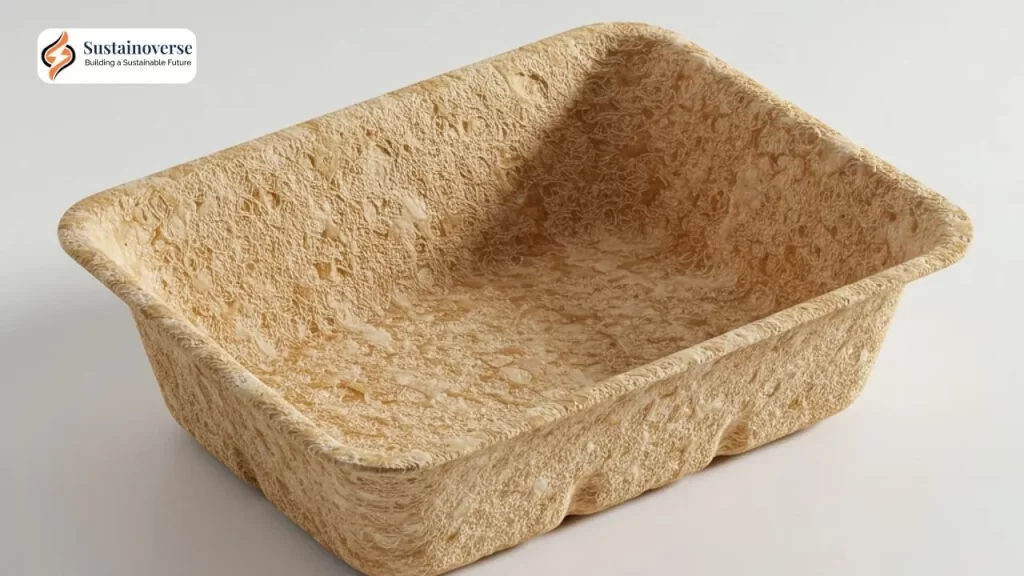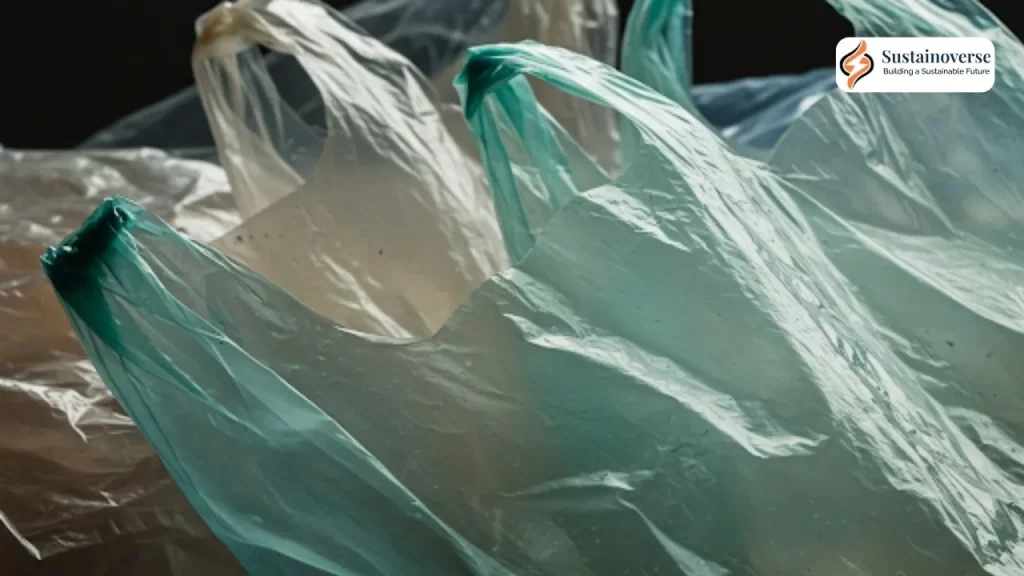Biomaterials are everywhere. From the packaging that wraps your food to the stitches used in surgery, these materials shape our daily lives. But not all biomaterials are created equal. Some break down naturally over time, while others stick around for centuries. This brings us to two main types: biodegradable and non-biodegradable biomaterials. The difference? Biodegradable ones decompose, leaving little to no waste. Non-biodegradable ones last much longer, but they can also lead to pollution. Let’s do a quick Visual Comparison of Biodegradable Vs. Non-Biodegradable Biomaterials.
In this article, we’ll compare these two types side by side, using simple explanations and visual comparisons to make things clear.
Let’s dive in!
Understanding Biomaterials
What are Biomaterials?
Biomaterials are materials designed to work with living systems. They can be natural (like collagen or silk) or engineered (like medical-grade plastics). These materials are widely used in medicine, packaging, construction, and even fashion.

Key Properties of Biomaterials:
- Safe for human or environmental contact
- Durable enough for their intended use
- Can be biodegradable or non-biodegradable
Did You Know?
The first recorded use of biomaterials dates back to 3000 BC, when ancient Egyptians used plant fibers, hair, tendons, and wool threads for surgical stitches!
You May Also Read: 7 Sustainable & Biodegradable Liquid HandSoaps You NEED in Your Bathroom
Why Does Biodegradability Matter?
Not all biomaterials break down the same way. Some decompose naturally within weeks, while others linger in landfills for centuries. This makes biodegradability a key factor in reducing pollution and waste.
The Environmental Impact
🌱 Biodegradable biomaterials help reduce landfill waste and ocean pollution. For example, a banana peel decomposes in about a month, while a plastic water bottle takes 450 years!
The following image shows a Visual Comparison of Biodegradable Vs. Non-Biodegradable Biomaterials.

🚯 Non-biodegradable biomaterials contribute to long-term waste and microplastic pollution. The world produces over 400 million tons of plastic waste annually, much of which is non-biodegradable.
The Economic Impact
💰 Industries are shifting towards biodegradable materials to cut waste disposal costs and meet sustainability goals. The biodegradable plastics market alone is projected to hit $23 billion by 2026!
Quick Thought:
If more companies switch to biodegradable materials, could we see a world with less plastic waste?
Biodegradable Biomaterials: Definition & Characteristics
A biodegradable biomaterial is a material that naturally breaks down over time with the help of microorganisms like bacteria and fungi. These materials decompose into water, carbon dioxide, and organic matter, leaving behind little to no waste.
The speed of decomposition depends on the material type and environmental conditions like temperature, moisture, and microbial activity. Some biodegradable materials break down in weeks, while others may take several months.
Real-Life Example: A paper bag decomposes in about 6 weeks, while a plastic bag can take up to 1,000 years!
Key Characteristics of Biodegradable Biomaterials
Decomposes Naturally – Microbes break it down into harmless substances.
Leaves Minimal Waste – Reduces pollution and landfill waste.
Sourced from Renewable Resources – Often made from plants, algae, or biopolymers instead of fossil fuels.
Examples of Biodegradable Biomaterials
1. Polylactic Acid (PLA)
What is it? PLA is made from fermented corn starch or sugarcane.
Where is it used? Food packaging, 3D printing, medical implants.
Decomposition time? 6 months to 2 years in industrial composting conditions.
2. Starch-Based Plastics
What is it? Plastics made from corn, potato, or tapioca starch.
Where is it used? Disposable cutlery, bags, packaging materials.
Decomposition time? 3 to 6 months under the right composting conditions.
3. Chitosan & Alginate-Based Biomaterials
What is it? Chitosan comes from shrimp shells, while alginate is extracted from seaweed.
Where is it used? Wound healing, food preservation, water purification.
Decomposition time? Weeks to months, depending on moisture and microbial activity.
Did You Know?
PLA plastic can be composted, but it won’t break down in a landfill due to a lack of oxygen and high temperatures. This is why proper waste disposal is key!
Non-Biodegradable Biomaterials: Definition & Characteristics
Unlike biodegradable materials, non-biodegradable biomaterials do not break down naturally in a short time. Instead, they can persist in the environment for decades or even centuries.
These materials are usually made from synthetic polymers, which are engineered for durability. While this makes them valuable for medical, industrial, and packaging applications, it also leads to waste buildup and pollution.
🔍 Real-Life Example: A plastic water bottle made from polyethylene (PE) can take up to 450 years to degrade!
Key Characteristics of Non-Biodegradable Biomaterials
❌ Long Lifespan – These materials can last years to centuries before breaking down.
⚠ Leads to Waste Accumulation – If not recycled, they contribute to landfills and ocean pollution.
🔬 High Durability – Ideal for medical implants, industrial applications, and everyday products.
Examples of Non-Biodegradable Biomaterials
1. Polyethylene (PE)
What is it? The most common plastic, used in grocery bags, bottles, and food containers.
Where is it used? Packaging, pipes, medical tubing.
Decomposition time? Up to 500 years in landfills.
2. Polypropylene (PP)
What is it? A tough plastic used in straws, bottle caps, and furniture.
Where is it used? Automotive parts, medical devices, textiles.
Decomposition time? 20 to 30 years, but remains as microplastics.
3. Silicone-Based Biomaterials
What is it? A synthetic material made from silicon, oxygen, and carbon.
Where is it used? Medical implants, prosthetics, cookware, electronics.
Decomposition time? Hundreds of years, but some medical-grade silicones are reusable and recyclable.
Did You Know?
Over 90% of all plastics ever produced still exist today in some form—either in landfills, oceans, or as microplastics in the environment!

Visual Comparison of Biodegradable vs. Non-Biodegradable Biomaterials
The following table shows the side by side visual comparison of biodegradable vs. non-biodegradable biomaterials.
| Feature | Biodegradable Biomaterials | Non-Biodegradable Biomaterials |
| Decomposition Time | Weeks to months | Decades to centuries |
| Environmental Impact | Low, eco-friendly | High, contributes to pollution |
| Common Uses | Packaging, sutures, food wraps | Implants, industrial plastics |
| Cost | Often higher initially | More affordable in mass production |
| Durability | Less durable over time | High durability and longevity |
Applications & Real-World Examples
Biomaterials are everywhere—whether in medicine, packaging, fashion, or technology. While biodegradable materials help reduce waste, non-biodegradable ones provide durability and longevity in critical applications.
Biodegradable Biomaterials in Action
These materials decompose naturally, making them ideal for short-term use while minimizing environmental impact.
#1 Medical: Absorbable sutures, tissue engineering.
How it works? Dissolvable stitches made from polyglycolic acid (PGA) or chitosan degrade safely inside the body.
Sustainability impact? Eliminates the need for removal procedures, reducing medical waste.
Example: Biodegradable scaffolds in tissue engineering help regrow damaged skin and organs.
#2 Packaging: Compostable containers, food wraps
How it works? PLA-based and starch-based packaging breaks down in composting conditions.
Sustainability impact? Reduces plastic waste in food packaging.

You May Also Read: Biodegradable Food Containers: An Ultimate Guide
Example: Brands like Eco-Products use compostable plates and cups made from plant fibers.
#3 Fashion: Sustainable fabrics like bacterial cellulose
How it works? Bacterial cellulose, grown by microbes, creates biodegradable textiles.
Sustainability impact? Unlike synthetic fabrics, it leaves no toxic microfibers in the environment.
Example: Mylo™ leather is made from mushroom mycelium, offering a vegan, biodegradable alternative to traditional leather.
Non-Biodegradable Biomaterials in Action
These materials are essential for long-term durability in critical fields like medicine, construction, and technology.
#1 Medical: Long-term implants, prosthetics
How it works? Non-biodegradable materials like titanium, polyethylene, and silicone ensure longevity in hip replacements, heart valves, and prosthetics.
Why it’s used? Must withstand years of wear without breaking down inside the body.
Example: Polyethylene joint replacements last up to 25 years.
#2 Construction: Plastic composites in buildings
How it works? High-strength polypropylene and polyethylene composites are used in pipes, roofing, and insulation.
Why it’s used? Weather-resistant, lightweight, and cost-effective.
Example: PVC roofing membranes last over 30 years, making them a popular choice for sustainable buildings.
#3 Electronics: Silicone-based materials in circuits
How it works? Silicone protects microchips, circuit boards, and phone screens from heat and moisture.
Why it’s used? Enhances durability and efficiency in modern technology.
Example: Every smartphone contains silicone-based components for waterproofing and flexibility.
Did You Know?
By 2050, the world is expected to generate 12 billion tons of plastic waste if we don’t shift to biodegradable alternatives!
You May Also Read: 7 Untapped Benefits of Biodegradable Dustbin Bags
Environmental Impact & Sustainability
Biomaterials play a crucial role in shaping our planet’s future. While biodegradable options help reduce waste, non-biodegradable materials pose serious environmental risks.
Let’s break down the impact of both.

You May Also Read: Biodegradable Garbage Bags: Your Ultimate Guide
How Biodegradable Biomaterials Reduce Waste & Pollution
Less Landfill Waste – Biodegradable materials break down naturally, preventing landfill overflow.
Lower Carbon Footprint – Many are sourced from renewable resources, reducing fossil fuel dependency.
Less Water & Soil Contamination – They don’t release toxic chemicals as they decompose.
📌 Example: Compostable food packaging made from PLA (Polylactic Acid) can break down in just 90 days under industrial composting conditions.
You May Also Read: Biodegradable Fishing Line: An Ultimate Guide to Sustainable Fishing
The Risks of Non-Biodegradable Materials
Microplastic Pollution – Tiny plastic particles enter oceans, soil, and even our food chain.
Low Recycling Rates – Less than 9% of plastic waste worldwide is successfully recycled.
Harm to Wildlife – Animals often mistake plastic for food, leading to injury and death.
📌 Example: The Great Pacific Garbage Patch is now over 1.6 million square kilometers—three times the size of France!
Future Innovations: Making Non-Biodegradable Biomaterials More Sustainable
Addressing the environmental impact of non-biodegradable biomaterials, particularly plastics, has spurred significant scientific advancements. Researchers are developing innovative materials and recycling methods to mitigate plastic waste.
Biodegradable Plastics: Advancements in bioplastics aim to create materials that decompose more efficiently, reducing environmental impact. For instance, scientists have engineered mutant enzymes capable of breaking down PET plastic in just a few hours, a process that traditionally takes centuries –Source [Nature].
Advanced Recycling: Chemical recycling methods are being developed to convert plastics back into raw materials for reuse. A study published in Nature Communications discusses the potential of chemical recycling to address plastic waste by converting it into valuable products.
Hybrid Materials: Some companies are combining natural fibers with plastics to reduce pollution. For example, Ecovative Design has developed mycelium-based materials that serve as sustainable alternatives to traditional plastics.
Did You Know? By 2050, plastic waste in the ocean could outweigh fish if we don’t take action!
These innovations represent promising steps toward reducing the environmental footprint of non-biodegradable biomaterials.
You May Also Read: 5 Items That Are Usually Recycled (And How to Do It Right)
Key Takeaways from Visual Comparison Biodegradable vs. Non-Biodegradable Materials
In summary, this visual comparison of biodegradable vs. non-biodegradable materials highlights the significant differences in their environmental impact and compatibility with biological systems. Biomaterials, especially bio-based and biodegradable options, provide safer, more sustainable alternatives for medical and ecological applications. Choosing the right material for the right purpose is essential for both performance and environmental sustainability.
Let’s make informed, sustainable choices by prioritizing biodegradable materials over non-biodegradable plastics. By shifting toward these eco-friendly options, we can help create a healthier planet and a more sustainable future.
You May Also Read: Your Ultimate Guide to the Best Biodegradable Gloves: Top 9 Picks
FAQs
1. What are biodegradable and non-biodegradable materials?
Biodegradable materials break down naturally through microorganisms, while non-biodegradable materials persist in the environment, causing pollution.
2. How do biodegradable materials benefit the environment?
Biodegradable materials reduce waste, lessen pollution, and support sustainable waste management by decomposing naturally.
3. Are all biodegradable materials compostable?
Not all biodegradable materials are compostable. Compostable items require specific conditions to break down into nutrient-rich compost.
4. What is the difference between biodegradable and compostable?
Biodegradable materials decompose naturally, while compostable materials break down in controlled environments to form compost.
5. How can I identify biodegradable products?
Look for eco-certifications like ASTM D6400 or EN 13432 to identify biodegradable and compostable products.
6. What are some examples of biodegradable materials?
Food waste, paper products, yard waste, and some packaging materials are common biodegradable items.
7. Why is it important to choose biodegradable over non-biodegradable materials?
Choosing biodegradable materials reduces pollution, conserves resources, and supports environmental sustainability.
8. Can biodegradable materials be recycled?
Some biodegradable materials can be recycled, but it’s important to check local recycling guidelines to avoid contamination.
9. Are biodegradable materials always better for the environment?
Biodegradable materials are environmentally friendly, but improper disposal or production can still lead to pollution.
10. Are all biodegradable materials compostable?
No, not all biodegradable materials are compostable. Compostable materials require specific conditions like heat and moisture to break down into nutrient-rich compost.
11. Why do industries still use non-biodegradable biomaterials?
Industries use non-biodegradable biomaterials due to their cost-effectiveness, durability, and the lack of viable alternatives that meet the same performance standards.
12. Is Plastic Biomaterial?
Plastic is generally not considered a biomaterial unless it is derived from renewable resources like plants. Traditional plastics are synthetic and non-biodegradable.

